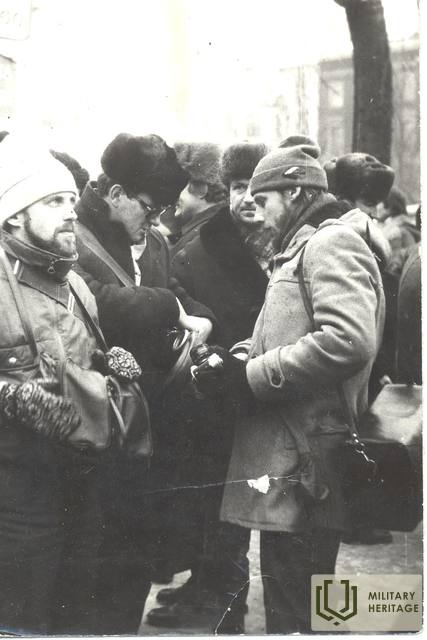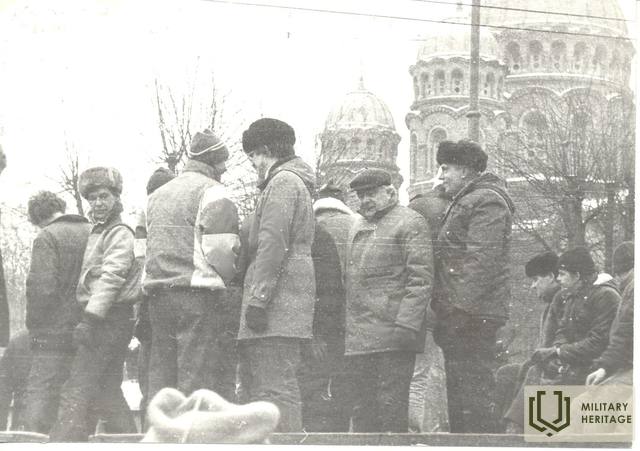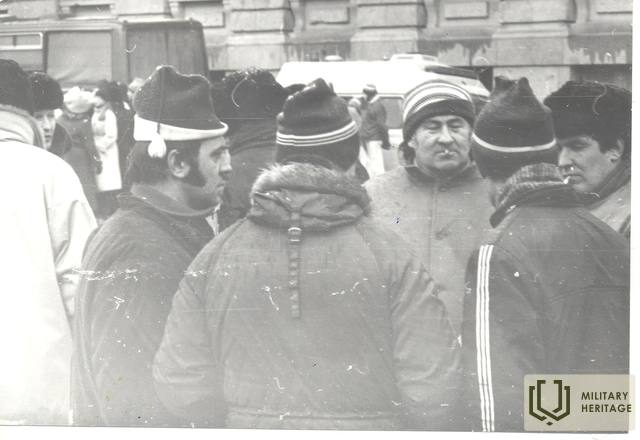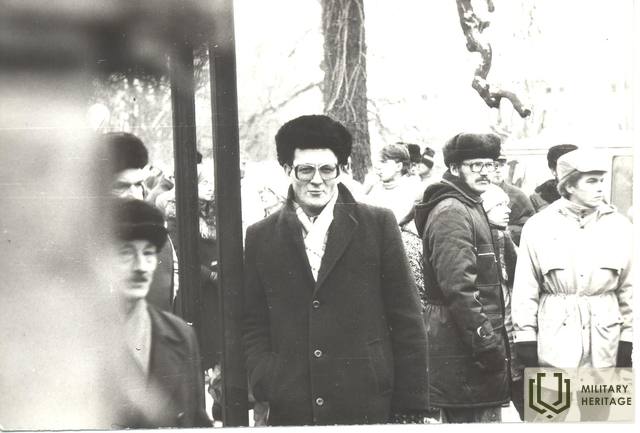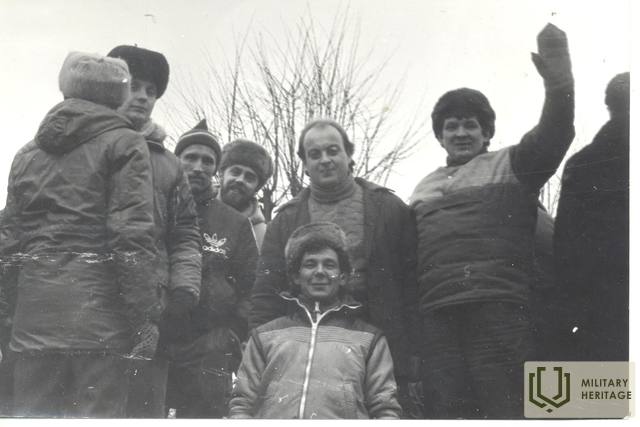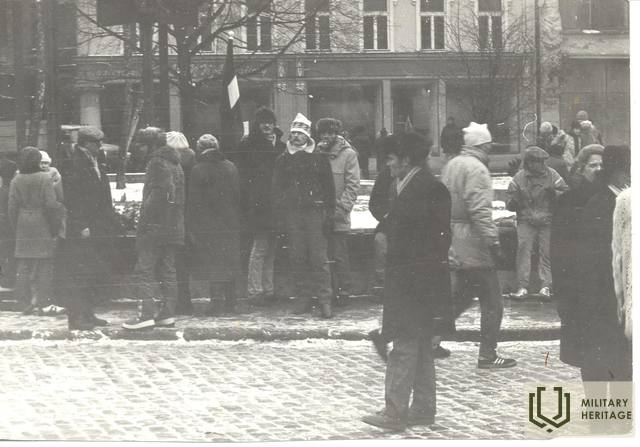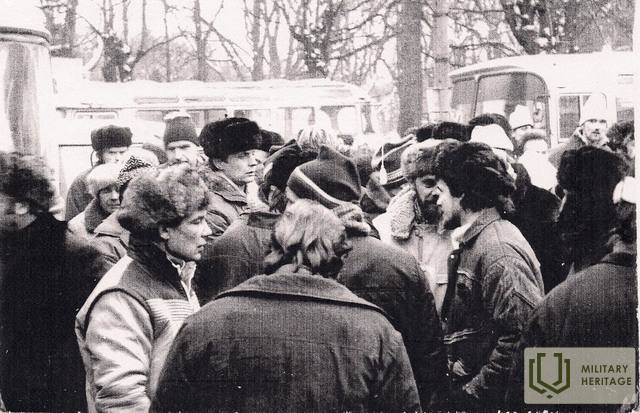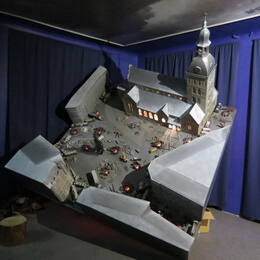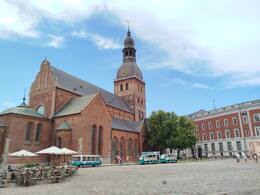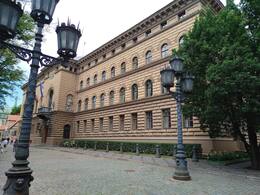Vaidavians on the barricades
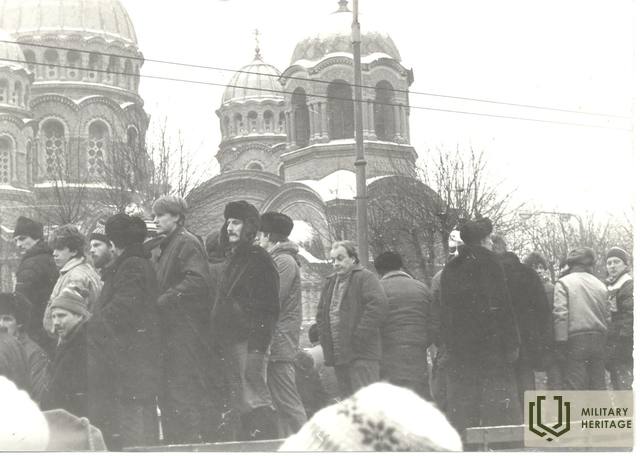
In 2020, in anticipation of the 30th anniversary of the 1991 barricades, Vismants Priedīte shares the story of the participation of local residents in these historical events.
The participants' march to protect the barricades began on the morning of January 14, when the first group of volunteer guards left for Riga.
The shipment was organized by Guntis Pīrāgs, Chairman of the Board of the collective farm “Vaidava”, Arnis Urbāns, Head of the Vaidava Group of the Latvian Popular Front, Construction Manager, and Modris Karselis, Chairman of the Vaidava Parish TDP Executive Committee.
The barricade guards' departure to the capital was closely coordinated with the leadership of the Valmiera district branch of the LTF, and after their arrival in Riga – with the leaders of the barricade organization center. The barricade guards were transported in shifts by the collective farm drivers Uldis Paltiņš and Valdis Jansons. The collective farm's heavy agricultural machinery did not go to Riga.
Participation in the defense of the barricades from January 14 to 26 was an event carried out by conviction, not by force. More than 30 people went to Riga every day. Departure for the 24-hour shift was at 8:00 p.m. People of various professions went to the barricades. Active participants were both drivers and mechanics of the communal farm, as well as electricians, people working in ceramics, teachers of the Vaidava nine-year school and the Vaidava special boarding school, and employees of other professions. Very many Vaidava residents went to the defense of the barricades repeatedly, 4-5 times.
The main area of operation for the Vaidavians was the protection of the building of the Council of Ministers of the Republic of Latvia. There were also two times on duty at the building of the Supreme Council of the Republic of Latvia. The task in the event of an attack by opponents of independence was to form a human shield behind the heavy equipment positioned in front of the building, as well as to observe the movement of transport and people and track suspicious people - possible provocateurs. The duration of the duty for each shift was 24 hours. After the bloody events of January 20, several Vaidavians donated blood for the treatment of the wounded.
Historian Vismants Priedīte
Related timeline
Related objects
Vaidava Parish Local History Permanent Exhibition
Located in the Vaidava Culture and Crafts Center.
An exhibition dedicated to the memory of the deportations of 1949, as well as the participation of the Vajdavians in the barricades in Riga in January 1991, is on display. The exhibition also features evidence of the world wars (mainly printed materials).
Natural and historical objects, manors, history of education, culture, notable people, materials from the collective farm era, household utensils, banknotes, newspapers, magazines about Vaidava parish.
1991 Barricades Museum
The museum is located in Old Riga near the Riga Cathedral. It was founded in 2001 to preserve historical evidence of the events of 1991 in Latvia. A virtual tour of the museum is also available. In January 1991, in Lithuania the Soviet Army opened fire on people who had gathered at the Vilnius TV tower and drove into the crowd with tanks. In response to these events a demonstration of about 500,000 people was organised in Riga to show support to Lithuanians and the readiness of the Latvian people to continue their struggles towards Latvia’s independence. In order to prevent similar events from happening in Latvia, residents began to build barricades in the narrow streets of Old Riga in order to prevent possible attacks of the Soviet Army on the defenders of the barricades. These barricades were also created at various strategic objects not only in Riga, but throughout all of Latvia. Around 50,000 people from all over Latvia participated in defending the barricades. Barricades was a popular movement that helped to regain Latvia’s independence. This is a great example of non-violent resistance in the history of the whole world.
Dome Square in Old Riga
The importance of Dome Square during the Awakening was determined mainly by two circumstances – it was located in the immediate vicinity of the building of the Supreme Council of the Latvian SSR, as well as the fact that the building of Latvian Radio is located on the square. Various actions were held on Dome Square, putting forward demands to the Supreme Council, for example, on July 26, 1989, the Latvian Federation of Labor organized a rally attended by 60,000 people, demanding that the Supreme Council adopt the Declaration of Sovereignty. It was at this rally that the then popular slogan “Something in the past, but in free Latvia” was raised.
Dome Square was the main gathering place for the defenders of the barricades in January 1991, protecting the Supreme Council and the Radio House. The defenders of the barricades warmed themselves by the bonfires. They also stayed in the Radio House and the Dome Church. A first aid station was set up in the church, and services were held. In the evenings, popular rock bands performed on an improvised stage in the square. Every year, events commemorating the barricades are held in Dome Square.
Near the Dome Square, at Krāmu Street 3, there is a museum of the 1991 barricades. On January 13, 2018, the stained glass window “With passion for a free Latvia” by artists Krišs and Dzintars Zilgalvji was unveiled in the Dome Church - a dedication to the 1991 barricades and the independence of Latvia.
Parliament House (Saeima)
The former Vidzeme Knights' House has been the home of the Latvian Parliament since 1922. During the Soviet occupation, a pseudo-parliament - the Supreme Council of the Latvian SSR - was located here. In the elections to the Supreme Council held in March 1990, the main issue was the restoration of Latvia's state independence. This was done in accordance with the position of the Latvian Popular Front, which stated that it was more realistic to do this using the existing power structures of the USSR. In order to win a qualified vote in the Supreme Council, 134 votes were needed.
On May 4, 1990, the Supreme Council of the Latvian SSR adopted the Declaration “On the Restoration of the Independence of the Republic of Latvia”. 138 voted in favor of its adoption, 1 abstained, but 57 deputies who advocated Latvia remaining part of the USSR did not participate in the vote. By adopting the Declaration, the 1922 Constitution was restored in the territory of Latvia, but until the adoption of a new version of the Constitution, its operation was suspended, except for the first three articles of the Constitution. Such a transitional period was determined until the convocation of the Saeima of the Republic of Latvia. May 4 is celebrated as the Day of the Restoration of the Independence of the Republic of Latvia.
On May 15, 1990, opponents of independence attempted to seize the Supreme Council with the help of military cadets dressed in civilian clothes, but the spontaneously organized students of the Polytechnic Institute and the Institute of Physical Culture repelled the attack. The second attempt to attack the Supreme Council was stopped by the militia (the OMON unit, which in June 1990 refused to submit to the government of the Republic of Latvia and became the main strike force of the opponents of independence).
The Supreme Council was one of the most important points of barricade protection in January 1991. The approaches to it were fenced off with reinforced concrete blocks, and these protective structures were there until the unsuccessful coup attempt in Moscow on August 19-21, 1991. Soviet paratroopers and OMON fighters were unable to occupy the Supreme Council, and its deputies continued their work. On August 21, at 1:00 p.m., four OMON armored personnel carriers entered the Dome Square and remained there until 2:10 p.m., trying to intimidate the deputies, who at that time (at 1:10 p.m.) adopted the Constitutional Law on the State Status of the Republic of Latvia (111 deputies voted for, 13 against). This abolished the transitional period established on May 4, 1990 for the de facto restoration of state power in the Republic of Latvia, and Latvia regained full independence. In 2007, a memorial site for the January 1991 barricades was opened near the Saeima building on Jēkaba Street, and in 2000, in honor of the 30th anniversary of the restoration of the independence of the Republic of Latvia, a commemorative plaque was installed next to the main entrance of the Saeima with the inscription: "In this building, on May 4, 1990, the deputies of the Supreme Council adopted a declaration on the restoration of the independence of the Republic of Latvia."
Bastejkalns neighborhood in Riga
The area around Bastejkalns includes several memorial sites from the barricade era. The square, located at the intersection of Smilšu and Torņa streets, opposite the Powder Tower, was named the 1991 Barricade Square in 2016. The heavy equipment stationed here protected Old Riga from invasion at a strategically important location. The nearby Latvian War Museum housed barricade post no. 1.
On January 20, 1991, an OMON attack on the Ministry of Internal Affairs took place in the vicinity of Bastejkalns, which took the lives of several people. In the canalside greenery, opposite Bastejkalns, at the places where the victims were mortally wounded, memorials have been erected - stones to militia lieutenant Vladimir Gamanovič, inspector of the internal affairs department Sergejs Kononenko, director of the Riga Film Studio Andris Slapiņš, schoolboy Edijs Riekstiņš and the shot cameraman Gvido Zvaigznes, who died on February 5. There is a version that the shooters were not only and not so much OMON members, but also some “third force” - either from the special unit “Alfa”, or employees of the USSR State Security Committee from Moscow, who provoked the OMON attack on the Ministry of Internal Affairs.
A memorial stone has also been installed in the canalside gardens to the victim of August 19, 1991, Raimonds Salmiņš, who was shot by riot police near the Riga City Police Department building at the intersection of Aspazijas Boulevard and 13. janvāra Street. In 2014, a memorial plaque dedicated to the victims of the January 20, 1991 attack on the Ministry of the Interior was installed near the former Ministry of the Interior building at the corner of Raina Boulevard and Reimersa Street.




